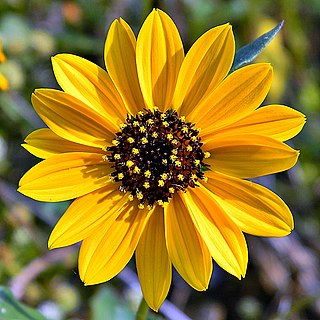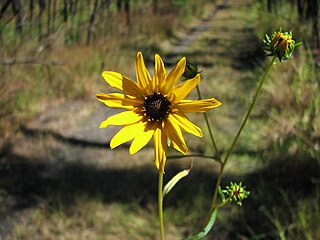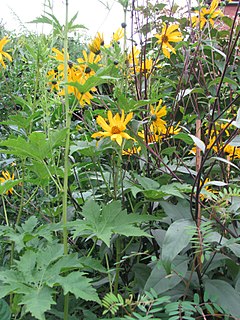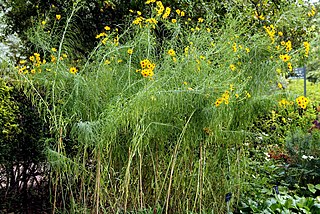
Helianthus annuus, the common sunflower, is a large annual forb of the genus Helianthus grown as a crop for its edible oil and edible fruits. This sunflower species is also used as wild bird food, as livestock forage, in some industrial applications, and as an ornamental in domestic gardens. The plant was first domesticated in the Americas. Wild Helianthus annuus is a widely branched annual plant with many flower heads. The domestic sunflower, however, often possesses only a single large inflorescence atop an unbranched stem. The name sunflower may derive from the flower's head's shape, which resembles the sun.

Helianthus is a genus comprising about 70 species of annual and perennial flowering plants in the daisy family Asteraceae. Except for three South American species, the species of Helianthus are native to North America and Central America. The common names "sunflower" and "common sunflower" typically refer to the popular annual species Helianthus annuus, whose round flower heads in combination with the ligules look like the sun. This and other species, notably Jerusalem artichoke, are cultivated in temperate regions and some tropical regions as food crops for humans, cattle, and poultry, and as ornamental plants. The species H. annuus typically grows during the summer and into early fall, with the peak growth season being mid-summer.

Helianthus nuttallii, or Nuttall's sunflower, is a species of sunflower native to northern, central, and western North America, from Newfoundland west to British Columbia, south to Missouri, New Mexico, and California.

Helianthus bolanderi is a species of sunflower known by the common names Bolander's sunflower and serpentine sunflower. It is native to California and Oregon, where it grows mainly in mountainous areas, often in serpentine soils. It has been found from southwestern Oregon as well as in northern and central California as far south as Santa Cruz County, with reports of a few isolated populations in southern California.
Helianthus ciliaris is a species of sunflower known by the common names Texas blueweed and yerba parda.

Helianthus maximiliani is a North American species of sunflower known by the common name Maximilian sunflower.

Helianthus occidentalis, the fewleaf sunflower or western sunflower, is a species of sunflower native to the Eastern and Central United States. It grows mostly in the Great Lakes Region and in the Ozarks, with additional populations scattered as far as Massachusetts, Texas, and the Florida Panhandle.

Helianthus petiolaris is a North American plant species in the sunflower family, commonly known as the prairie sunflower or lesser sunflower. Naturalist and botanist Thomas Nuttall was the first to describe the prairie sunflower in 1821. The word petiolaris in Latin means, “having a petiole”. The species originated in Western United States, but has since expanded east. The prairie sunflower is sometimes considered a weed.

Helianthus debilis is a species of sunflower known by the common names cucumberleaf sunflower, beach sunflower, weak sunflower, and East Coast dune sunflower. It is native to the United States, where it can be found along the Atlantic and Gulf Coasts. It is known elsewhere as an introduced species, such as South Africa, Australia, Taiwan, Slovakia, and Cuba.

Helianthus decapetalus, known by the common names thinleaf sunflower and thin-leaved sunflower, is a perennial forb in the sunflower family. It is native to the Eastern and Central United States and Canada, from New Brunswick west to Iowa, Wisconsin, and Ontario, south as far as Georgia and Louisiana. It produces yellow composite flowers in late summer or early fall.

Helianthus eggertii, known as Eggert's sunflower, is a North American species of flowering plants in the sunflower family. It is native to Tennessee, Kentucky, South Carolina, and Alabama. It is best known as one of the few plants to have been delisted under the Endangered Species Act because of the species' recovery. It was described by John Kunkel Small in 1903.

Helianthus agrestis is a species of sunflower known by the common name southeastern sunflower. It is one of 150 sunflower species in the genus Helianthus. It is found only in the states of Florida and Georgia in the southeastern United States. This plant is native to Florida. It grows in wet soil in marshes and pine flatwoods at elevations less than 50 meters elevation.

Helianthus atrorubens is a North American species of sunflower known by the common name purpledisc sunflower. It is native to the southeastern United States. It is found in all the coastal states from Louisiana to Virginia, plus the inland states of Kentucky and Tennessee.
Helianthus heterophyllus is a species of sunflower known by the common names variableleaf sunflower and wetland sunflower. It is native to the coastal plain of the southern United States from Texas to North Carolina.

Helianthus hirsutus is a North American species of sunflower known by the common name hairy sunflower. It is widespread across south-central Canada, the eastern and central United States, and northeastern Mexico. It ranges from Ontario south to Florida, Coahuila, and Nuevo León, and west as far as Minnesota, Nebraska, and Texas.
Helianthus laciniatus is a North American species of sunflower known by the common name alkali sunflower. It is found in the southwestern United States and north-central Mexico. It is fairly common in the Chihuahuan Desert.

Helianthus porteri is a species of sunflower known by the common names Porter's sunflower, Stone Mountain daisy and Confederate daisy. It is native to the southeastern United States, such as Alabama and Georgia, but has been introduced to granite outcrop areas in North Carolina where it is aggressively weedy.
Helianthus praetermissus is a rare and probably extinct North American species of sunflower, with the common names New Mexico sunflower and lost sunflower. It is known from only one specimen collected in 1851 in Cibola County in western New Mexico, and not seen since.

Helianthus salicifolius is a North American species of sunflower known by the common name willowleaf sunflower. It is native to the central United States, primarily in the Great Plains and Ozark Plateau. There are a few reports of scattered populations in the Northeast and Midwest parts of the country, but these appear to be escapes from cultivation.
Helianthus smithii is a rare North American species of sunflower known by the common name Smith's sunflower. It is native to the southeastern United States, in Tennessee, Alabama, and Georgia.
















